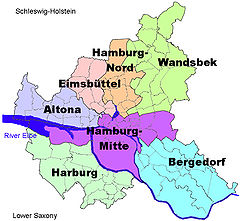Hamburg-Bergedorf
| Bergedorf | ||
|---|---|---|

The small harbour in Bergedorf.
|
||
|
||
| Coordinates: 53°29′14″N 10°12′37″E / 53.48722°N 10.21028°ECoordinates: 53°29′14″N 10°12′37″E / 53.48722°N 10.21028°E | ||
| Country | Germany | |
| State | Hamburg | |
| City | Hamburg | |
| Area | ||
| • Total | 154.8 km2 (59.8 sq mi) | |
| Population (1-1-2006) | ||
| • Total | 118,942 | |
| • Density | 770/km2 (2,000/sq mi) | |
| Time zone | CET/CEST (UTC+1/+2) | |
| Dialling codes | 040 | |
| Vehicle registration | HH | |
Bergedorf (German pronunciation: [ˈbɛʁɡədɔʁf]) is the largest of the seven boroughs of Hamburg, Germany, named after a quarter within this borough. In 2006 the population of the borough was 118,942.
The city of Bergedorf received town privileges in 1275, then a part of the younger Duchy of Saxony (1180–1296), which was partitioned by its four co-ruling dukes in 1296 into the branch duchies of Saxe-Lauenburg and Saxe-Wittenberg. Bergedorf then became part of the former. This was only to last until 1303, when Lauenburg's three co-ruling dukes, Albert III, Eric I, and John II partitioned their branch duchy into three smaller duchies.
Eric then held Bergedorf (Vierlande) and Lauenburg and inherited the share of his childless brother Albert III, Saxe-Ratzeburg, after he was already deceased in 1308 and a retained section from Albert's widow Margaret of Brandenburg-Salzwedel on her death. However, his other brother, John II, then claimed a part, so in 1321 Eric conceded Bergedorf (with Vierlande) to him, whose share thus became known thereafter as Saxe-Bergedorf-Mölln while Eric's was known as Saxe-Ratzeburg-Lauenburg.
In 1370, John's fourth successor Eric III pawned the Herrschaft of Bergedorf, the Vierlande, half the Saxon Wood and Geesthacht to Lübeck in return for a credit of 16,262.5 Lübeck marks. This acquisition included much of the trade route between Hamburg and Lübeck, thus providing a safe passage for freight between the cities. Eric III only retained a life tenancy.
...
Wikipedia



